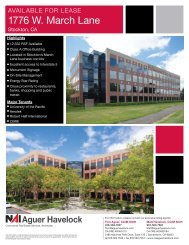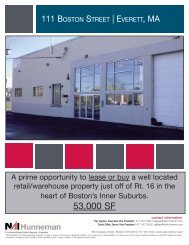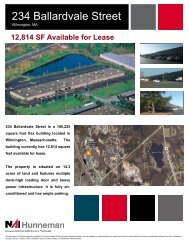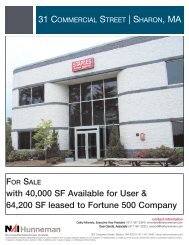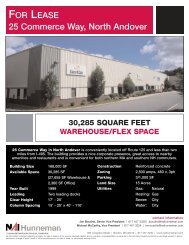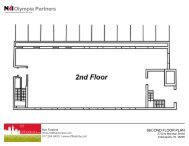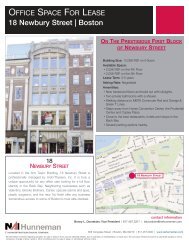2012 Global Market report - NAI Global
2012 Global Market report - NAI Global
2012 Global Market report - NAI Global
Create successful ePaper yourself
Turn your PDF publications into a flip-book with our unique Google optimized e-Paper software.
short-term leases, the multifamily sector will be able to best combat rising debt costs<br />
should the economy experience a severe inflationary spike.<br />
Through 2014, we expect aggregate demand growth to be about 850,000 units, with<br />
no net increase in supply. Thus, the current excess vacancy of 634,000 multifamily units<br />
will fall to a shortage of about one million units.<br />
Retail<br />
At 10.28%, NCREIF’s Q3 2011 retail vacancy rate increased from 10.1% in the second<br />
quarter, and was 68 bps lower than the same period one year earlier. The vacancy rate<br />
broke 6% in the second quarter of 2008, for the first time since 1999.<br />
The Conference Board Consumer Confidence Index stood at 39.8 in October 2011,<br />
close to an all-time low. In the first quarter of the year, it climbed to 72, but has since lost<br />
ground as the global economic uncertainty dominates the news. Real retail sales peaked<br />
at $363 billion in November 2007, dropped to $311 billion in March 2009, and have since<br />
regained lost ground, ending October 2011 at $352 billion (real 2011 $). Retail construction<br />
has been declining steadily on a monthly annualized basis, and was recorded at just $26<br />
billion as of September 2011, down from its October 2007 high of $65 billion.<br />
The International Council of Shopping Centers (ICSC) publishes the Weekly Leading<br />
Indicator of Shopping Center Sales, which has shown modest improvement over the last<br />
six months. Prior to the recession, the index peaked at 309 in July 2007, but declined to<br />
a low of 293 in April 2011. It has subsequently risen by 1.9% to 299 as of September<br />
2011. However, the ICSC-Goldman Sachs Weekly Chain Store Sales Index has been flat<br />
for the first nine months of 2011. ICSC’s Shopping-Center Executive Barometer of Future<br />
Business is a compilation of components including sales, customer traffic, occupancy<br />
rates, rent spreads and capitalization rates, where a reading over 50% indicates a growth<br />
sentiment. This index hit a low of 26.3% in December 2008, rose to 60.7% in May 2011,<br />
and stood at 52.2% in August 2011.<br />
Hotel<br />
Smith Travel Research <strong>report</strong>s that the 12-month rolling average US hotel occupancy<br />
rate declined from 1995-2002. Occupancy peaked again in June of 2006 at 63.7%, but<br />
declined to 55% in late 2009 and stood at 59.6% through September 2011, still<br />
historically low. The 12-month rolling average revenue per available room (RevPAR)<br />
ceased its 5-year ascent, peaking in May 2008 at $66.20 and then falling to $60.07 as<br />
of September 2011. STR also <strong>report</strong>ed that the change in the nation’s supply of rooms<br />
lagged the change in demand for those rooms on a 12-month rolling average basis. US<br />
hotel markets have begun to strengthen slightly through Q3 2011.<br />
Seniors Housing<br />
Stabilized occupancy rates for the independent living segment increased 40 bps in Q3<br />
2011 at 87.9%, while the average occupancy for majority assisted living properties<br />
improved by just 10 bps in Q3 to 88.6%. The correlations between employment and IL<br />
and AL occupancy rates between 2005 and Q2 2009 were 95% and 92%, respectively.<br />
However, when the last nine quarters of data are included in the analysis, the correlations<br />
decline significantly to 37% for IL and 59% for AL, primarily because even as jobs have<br />
<strong>2012</strong> <strong>Global</strong> <strong>Market</strong> Report n www.naiglobal.com<br />
10



